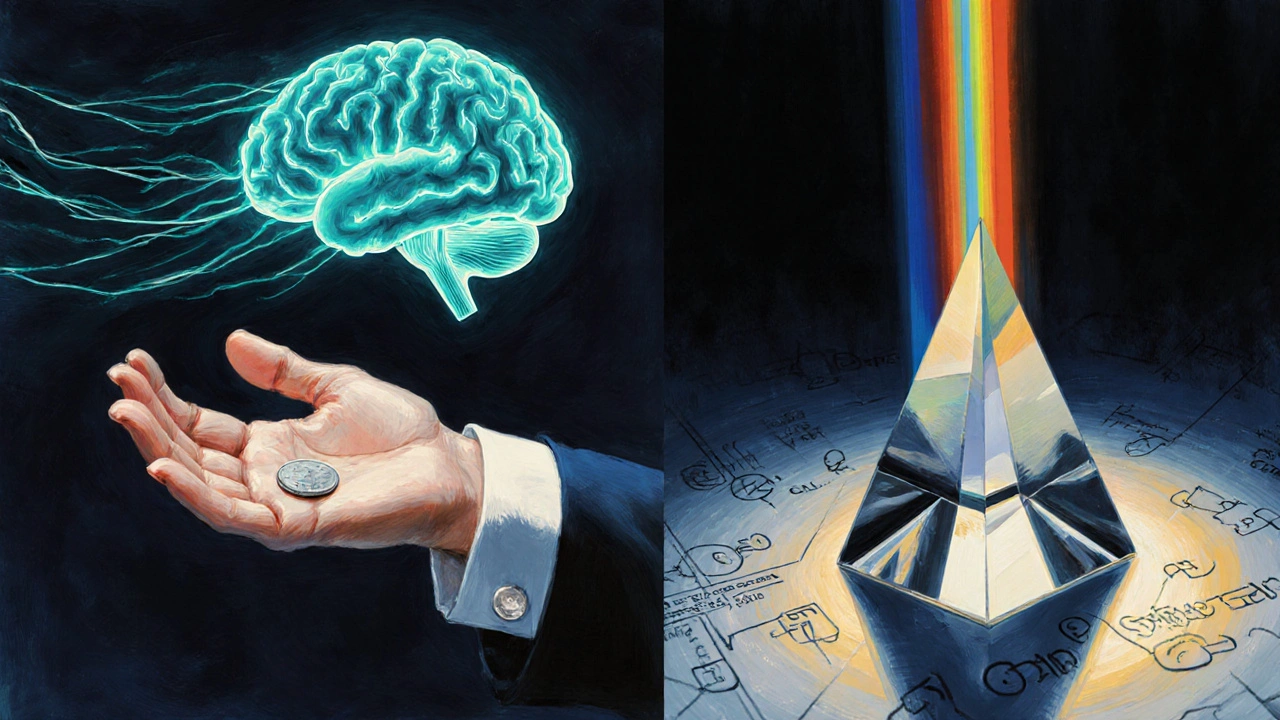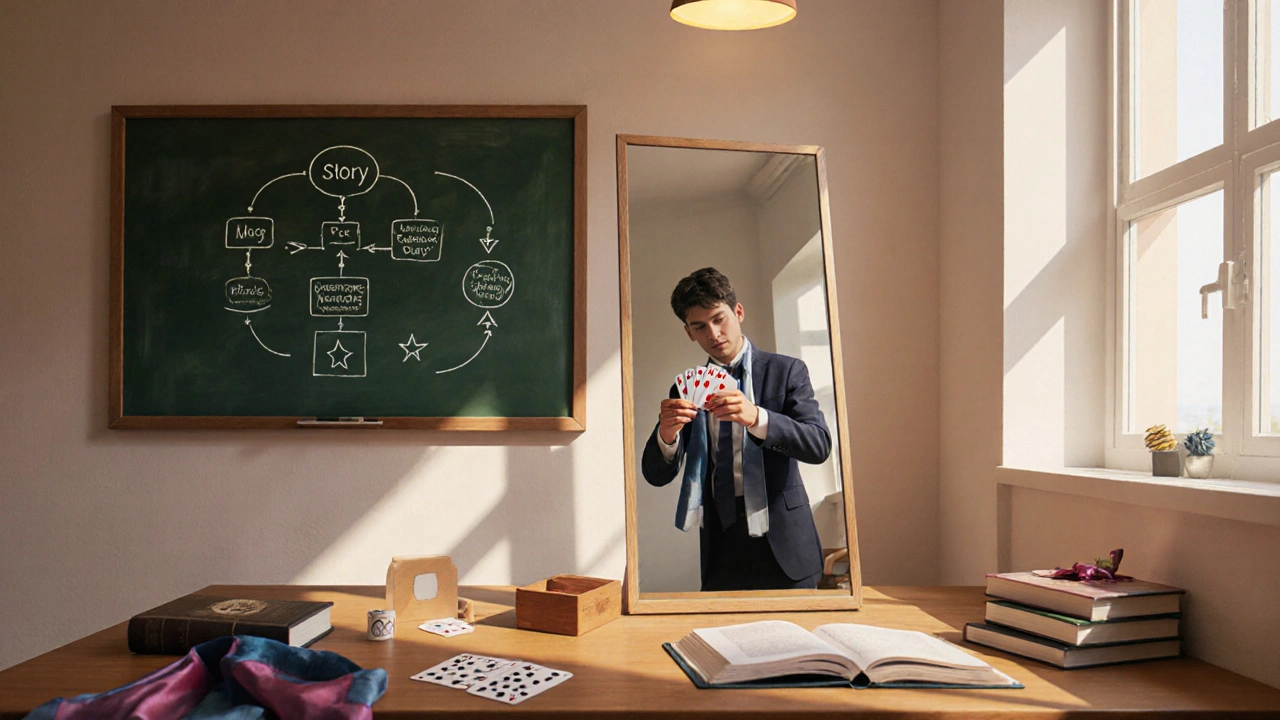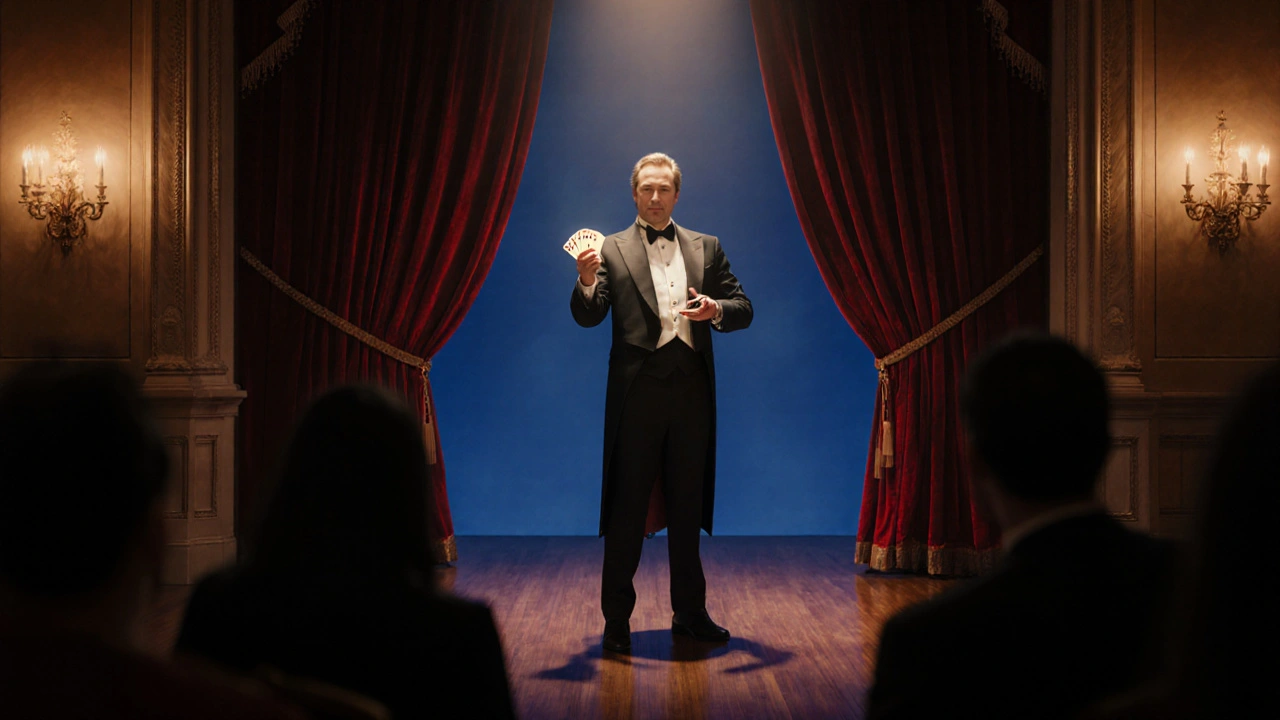Misdirection Impact Calculator
Enter your intended misdirection percentage to see how much it impacts audience memory recall:
Based on cognitive science from the article:
Misdirection exploits attentional bottlenecks - your brain can only process a fraction of stimuli at once. Studies show that well-timed misdirection can reduce recall of critical events by up to 60%.
Estimated Impact
With 50% misdirection, audience recall of key actions would be reduced by approximately 25%.
This means 75% of your audience would still remember the critical method.
The world of magic tricks isn’t just about pulling a rabbit out of a hat - it’s a seamless blend of creativity, psychology, and physics that turns ordinary moments into unforgettable wonder.
The Art of Magic: Storytelling and Showmanship
At its core, a magic performance is a piece of performance art that combines theatrical flair, timing, and audience interaction to craft a compelling narrative. Great magicians think like directors: they set the scene, build tension, and deliver a climax that feels both surprising and inevitable.
Key artistic elements include:
- Character and persona - the magician’s unique style that resonates with the audience.
- Music and lighting - tools that shape mood and focus attention.
- Story arcs - short stories woven around a trick to give it emotional weight.
When these pieces click, the audience isn’t just watching a trick; they’re experiencing a mini‑theater, which makes the illusion feel more personal and memorable.
The Science Behind Magic: How Our Minds Get Fooled
Every successful illusion leans on the quirks of human perception. Our brain is a pattern‑seeking machine, and magicians exploit the gaps between what we see, what we think we see, and what actually happens.
Important scientific concepts include:
- Perception the process by which sensory information is interpreted, often filling in missing details. This creates blind spots that magicians can hide moves in.
- Cognition mental processes like attention and memory that can be manipulated through suggestion. By guiding attention, a magician can make a crucial move invisible.
- Physics principles such as inertia, optics, and fluid dynamics that underpin many ‘impossible’ effects. Understanding forces lets a performer design tricks that defy everyday expectations.
Research from cognitive psychologists shows that misdirection can reduce a viewer’s recall of an event by up to 60%. That’s why a well‑timed gesture can erase a critical sleight from memory.

Core Techniques: From Sleight of Hand to Mechanical Marvels
Sleight of hand a set of manual dexterity moves, such as palming, false transfers, and double lifts is the magician’s most timeless tool. Mastery often requires thousands of repetitions, but the payoff is a seamless illusion that feels “natural”.
Equally vital is misdirection the deliberate steering of audience attention away from the method. It can be visual (a flash of light), auditory (a sudden sound), or psychological (a surprise question).
When manual skill hits its limits, magicians turn to mechanical devices hidden compartments, springs, and electromagnets that automate part of the effect. Modern tricks often blend these devices with traditional sleight, creating hybrid performances that look effortless.
Designing a Trick: Marrying Art and Science
Creating a new illusion is a two‑step dance. First, the magician sketches the artistic narrative - who is the performer, what is the emotional hook, how will the climax surprise the crowd. Second, they layer the scientific foundation, deciding which perceptual blind spot to exploit and which physical principle will make the effect possible.
Below is a quick comparison that helps break down each component:
| Aspect | Artistic Element | Scientific Basis |
|---|---|---|
| Storytelling | Character development, emotional hook | Memory encoding - stories improve recall of the effect |
| Stage Design | Lighting, props, music | Visual perception - contrast and color guide focus |
| Method | Sleight of hand moves | Motor control and speed - faster moves stay out of sight |
| Misdirection | Gestures, patter, surprise questions | Attentional bottleneck - only a fraction of stimuli are processed |
| Props | Elegant, theme‑consistent objects | Physics of motion - leverage, inertia, hidden mechanisms |
Notice how each artistic choice has a scientific counterpart. When both sides are aligned, the illusion feels inevitable yet astonishing.
Learning Path: From Amateur to Skilled Illusionist
If you’re curious about diving into magic, follow this practical roadmap:
- Start with the basics: Learn three core sleight‑of‑hand moves - the classic palm, the double lift, and the false shuffle.
- Study perception: Read “Thinking, Fast and Slow” (Daniel Kahneman) or “Sleights of Mind” (Ricky Jay) to understand how attention works.
- Practice with a mirror: Record yourself, then watch the footage to spot unintended cues.
- Join a community: Local magic clubs or online forums (e.g., The Magic Café) provide feedback and new ideas.
- Build a simple routine: Combine a story, a single sleight, and a misdirection cue. Perform for friends and iterate.
Remember, the most effective magicians treat practice like a scientific experiment - hypothesize, test, analyze, and refine.

Common Pitfalls and Pro Tips
Even seasoned performers stumble. Here are typical errors and how to dodge them:
- Over‑explaining the story - keeps the audience’s mind busy, reducing their ability to notice the method.
- Relying on a single misdirection cue - audiences can recover quickly; layer visual and auditory diversions.
- Ignoring ergonomics - awkward hand positions slow you down and increase the chance of a slip.
- Skipping rehearsal with real props - a prop that feels different in hand can betray the method.
Pro tip: incorporate a “fail‑fast” routine - a quick test that reveals if a secret move was seen. If the test fails, adjust the timing or angle before the next performance.
Next Steps & Troubleshooting
Whether you’re prepping for a birthday party or a stage show, keep these troubleshooting cues in mind:
- Audience disengagement: Increase interaction - ask a question or involve a volunteer.
- Unintended reveal: Identify the exact moment the audience saw the method; tweak the misdirection or angle.
- Physical strain: Break down complex moves into smaller components; practice each slowly before speeding up.
By treating each performance as a data point, you’ll continuously sharpen both the artistic flair and scientific precision that define great magic.
Frequently Asked Questions
Can I learn magic tricks without buying expensive equipment?
Absolutely. Most foundational tricks rely on everyday objects-cards, coins, or a simple silk. The real value lies in mastering sleight of hand and misdirection, which cost nothing but time.
Why do some tricks feel ‘scientific’ while others feel purely artistic?
It’s a spectrum. A card vanish relies heavily on perception and physics, whereas a story‑driven mentalism routine leans more on psychology and narrative. The best tricks blend both ends of the spectrum.
How can I improve my audience’s memory of my performance?
Integrate a strong emotional hook - humor, surprise, or awe. Emotional arousal strengthens memory consolidation, making the illusion linger long after the curtain falls.
What’s the role of neuroscience in modern magic?
Neuroscience explains how the brain fills gaps, predicts outcomes, and filters out “irrelevant” information. Understanding neural pathways lets magicians design tricks that exploit predictive coding, making the impossible feel natural.
Is it ethical to use psychological tricks on audiences?
When performed transparently as entertainment, psychological techniques are widely accepted. Problems arise only when deception extends beyond the performance context, such as in sales or personal manipulation.


Reshma Jose
October 9, 2025 AT 18:40That misdirection calculator is pretty neat, it really shows how our brains get hijacked by the flash of a hand move. I love how you broke down the percentages into something we can actually picture. It makes me want to try a few tricks at the next family gathering and see if anyone notices. The layered approach you mention could be a game changer for beginners. Keep sharing these science‑backed tips, they’re super helpful!
rahul shrimali
October 9, 2025 AT 19:46Cool tool, love the quick visual.
Eka Prabha
October 9, 2025 AT 20:53The presented data appears to be a reductionist oversimplification of complex neurocognitive mechanisms. One must consider the epistemic uncertainty inherent in extrapolating laboratory findings to stage performance contexts. Moreover, the implicit suggestion that misdirection is a benign manipulative tool disregards ethical ramifications. The author should incorporate a more rigorous methodological framework.
Bharat Patel
October 9, 2025 AT 22:00Interesting take on the ethics, but I'd argue that magic has always been about illusion, not deception. As long as the audience consents to be amazed, the line feels thin. Still, your point about transparency is worth pondering.
Bhagyashri Zokarkar
October 9, 2025 AT 23:06i was watching a street magician yesterday and i thought wow that was insane i mean the way he flicked his wrist and the coin just vanished into thin air it was like my brain couldnt keep up at all i tried to follow the moves but the colors and sounds kept changing like a rapid fire show and i realized the misdirection was not just visual it was also auditory my ears were bombarded by a sudden drum beat while his hand moved fast and i felt my attention jump like a rabbit yeah that slider thing in the article shows exactly how much we lose when we get distracted it says up to sixty percent and that really makes sense after i saw that trick i even tried the calculator on my phone i set the diversion to seventy five percent and the bar grew all the way to the right it felt like the magic was actually measurable i love the idea of layering misdirection like a cake each layer adding more sweetness i think a little bit of sound a flash of light and a subtle hand motion can create a perfect storm for the audience and i cant wait to test it at the next party i might even write my own little app to see how different combos affect recall i hope this community keeps sharing these science backed tricks its like we are turning mystery into a hobby you can actually study and improve with data
Rakesh Dorwal
October 10, 2025 AT 00:13You nailed it with the layered misdirection, it’s like protecting our cultural heritage from foreign influence. Our traditions thrive when we master the art of distraction to keep the narrative pure. Keep the tips coming, they help us stay strong.
Vishal Gaur
October 10, 2025 AT 01:20Look, i get that the calculator is neat but i think it oversimplifies stuff like a lot. The whole 60% thing sounds cool but in real life you cant just set a slider and expect it to work. Also, the code snippet seems half‑baked, some brackets are missing and the comment stops mid‑sentence. If you want a reliable tool, maybe test it on a real audience first. Still, kudos for trying to blend tech with magic.
Nikhil Gavhane
October 10, 2025 AT 02:26Thanks for the honest feedback. It’s great that you’re thinking critically about the implementation, that’s how we improve. I’ll double‑check the script and maybe add a demo video so people can see it in action. Your encouragement means a lot.
Rajat Patil
October 10, 2025 AT 03:33I appreciate the balanced perspective presented here. The combination of scientific insight with practical tools is commendable. I look forward to further discussions on ethical applications of misdirection.
deepak srinivasa
October 10, 2025 AT 04:40Seeing the interplay between attention and memory in magic really broadens our understanding of cognitive load. It would be interesting to compare these findings with similar studies in advertising. Perhaps future posts could explore that crossover.
pk Pk
October 10, 2025 AT 05:46Great work on turning theory into a hands‑on calculator! For anyone looking to dive deeper, I suggest experimenting with different sensory cues while tracking recall rates. This iterative approach will sharpen both your performance and your grasp of the underlying science.